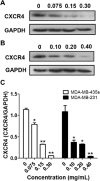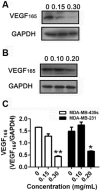Eupolyphaga sinensis Walker Ethanol Extract Suppresses Cell Growth and Invasion in Human Breast Cancer Cells
- PMID: 26242891
- PMCID: PMC5736081
- DOI: 10.1177/1534735415598224
Eupolyphaga sinensis Walker Ethanol Extract Suppresses Cell Growth and Invasion in Human Breast Cancer Cells
Abstract
Aim of the study: To examine the antiproliferation and anti-invasion of Eupolyphaga sinensis Walker 70% ethanol extract (ESWE) on breast cancer and elucidate the underlying signaling mechanisms.
Methods: MTT and colony formation assays were used to investigate the effect of ESWE on proliferation of breast cancer cells in vitro. The xenograft mouse tumor model was used to determine the effect of ESWE on breast cancer in vivo. To investigate the underlying molecular mechanisms, we used western blotting to analyze the expression of ERK1/2, CXCR4, matrix metalloproteinase 2 (MMP2), and MMP9 pretreated with ESWE. The stromal cell-derived factor (SDF)-1α-induced migration and invasion potential of breast cancer cells were examined by wound-healing assays and Matrigel invasion chamber assays.
Results: ESWE effectively inhibited the proliferation of MDA-MB-435s and MDA-MB-231 cells and exhibited antitumor effects in an MDA-MB-231 xenograft mice model. Furthermore, ESWE suppressed the activity of ERK1/2, a key molecule of MAPK signaling. We also observed that ESWE treatment led to downregulation of CXCR4 expression as well as greatly reduced MMP2 and MMP9. ESWE affected CXCR4 expression partially through the modulation of autocrine vascular endothelial growth factor. However, suppression of CXCR4 expression was the result of downregulation of mRNA expression. Inhibition of CXCR4 expression by ESWE further correlated with the suppression of SDF-1α-induced migration and invasion in breast cancer cells.
Conclusion: ESWE exerted its antiproliferation and antiinvasion by regulating MAPK signaling and related metastasis factorsand thus could be a useful therapeutic candidate for breast cancer intervention.
Keywords: CXCR4; ERK1/2; Eupolyphaga sinensis Walker; MMP2; MMP9; breast cancer.
© The Author(s) 2015.
Conflict of interest statement
Figures








Similar articles
-
Eupolyphaga sinensis Walker demonstrates angiogenic activity and inhibits A549 cell growth by targeting the KDR signaling pathway.Mol Med Rep. 2014 Sep;10(3):1590-6. doi: 10.3892/mmr.2014.2387. Epub 2014 Jul 16. Mol Med Rep. 2014. PMID: 25059654
-
Eupolyphaga sinensis walker displays inhibition on hepatocellular carcinoma through regulating cell growth and metastasis signaling.Sci Rep. 2014 Jul 1;4:5518. doi: 10.1038/srep05518. Sci Rep. 2014. PMID: 24980220 Free PMC article.
-
Platycodin D inhibits migration, invasion, and growth of MDA-MB-231 human breast cancer cells via suppression of EGFR-mediated Akt and MAPK pathways.Chem Biol Interact. 2013 Oct 5;205(3):212-21. doi: 10.1016/j.cbi.2013.07.002. Epub 2013 Jul 16. Chem Biol Interact. 2013. PMID: 23867902
-
Oleandrin and Its Derivative Odoroside A, Both Cardiac Glycosides, Exhibit Anticancer Effects by Inhibiting Invasion via Suppressing the STAT-3 Signaling Pathway.Int J Mol Sci. 2018 Oct 26;19(11):3350. doi: 10.3390/ijms19113350. Int J Mol Sci. 2018. PMID: 30373171 Free PMC article. Review.
-
Scoping review of the medicinal effects of Eupolyphaga sinensis Walker and the underlying mechanisms.J Ethnopharmacol. 2022 Oct 5;296:115454. doi: 10.1016/j.jep.2022.115454. Epub 2022 Jun 11. J Ethnopharmacol. 2022. PMID: 35700853
Cited by
-
A minireview of the medicinal and edible insects from the traditional Chinese medicine (TCM).Front Pharmacol. 2023 Mar 16;14:1125600. doi: 10.3389/fphar.2023.1125600. eCollection 2023. Front Pharmacol. 2023. PMID: 37007003 Free PMC article. Review.
-
A periodic review of chemical and pharmacological profiles of Tubiechong as insect Chinese medicine.RSC Adv. 2021 Oct 19;11(54):33952-33968. doi: 10.1039/d1ra05425b. eCollection 2021 Oct 18. RSC Adv. 2021. PMID: 35497279 Free PMC article. Review.
-
A Polysaccharide From Eupolyphaga sinensis Walker With Anti-HBV Activities In Vitro and In Vivo.Front Pharmacol. 2022 Mar 3;13:827128. doi: 10.3389/fphar.2022.827128. eCollection 2022. Front Pharmacol. 2022. PMID: 35308231 Free PMC article.
-
Gan-Qing-Ning Formula Inhibits the Growth of Hepatocellular Carcinoma by Promoting Apoptosis and Inhibiting Angiogenesis in H22 Tumor-Bearing Mice.Evid Based Complement Alternat Med. 2020 Aug 6;2020:6376912. doi: 10.1155/2020/6376912. eCollection 2020. Evid Based Complement Alternat Med. 2020. PMID: 32831873 Free PMC article.
-
Reversing the Tumor Target: Establishment of a Tumor Trap.Front Pharmacol. 2019 Aug 12;10:887. doi: 10.3389/fphar.2019.00887. eCollection 2019. Front Pharmacol. 2019. PMID: 31456685 Free PMC article. Review.
References
-
- Feng Y, Zhao M, He Z, Chen Z, Sun L. Research and utilization of medicinal insects in China. Entomol Res. 2009;39:313-316.
-
- Ahn MY, Ryu KS, Lee YW, Kim YS. Cytotoxicity and L-amino acid oxidase activity of crude insect. Arch Pharm Res. 2000;23:5. - PubMed
-
- Xu L, Lao XL, Ge A, Yu S, Li J, Mansky PJ. Chinese herbal medicine for cancer pain. Integr Cancer Ther. 2007;6:208-234. - PubMed
-
- Cai HB, Sun XG, Liu ZF, et al. Effects of dahuangzhechong pills on cytokines and mitogen activated protein kinase activation in rats with hepatic fibrosis. J Ethnopharmacol. 2010;132:157-164. - PubMed
Publication types
MeSH terms
Substances
LinkOut - more resources
Full Text Sources
Other Literature Sources
Medical
Research Materials
Miscellaneous

